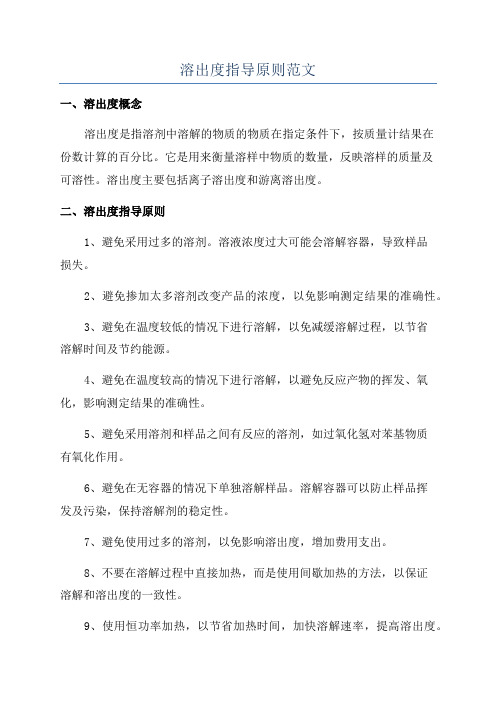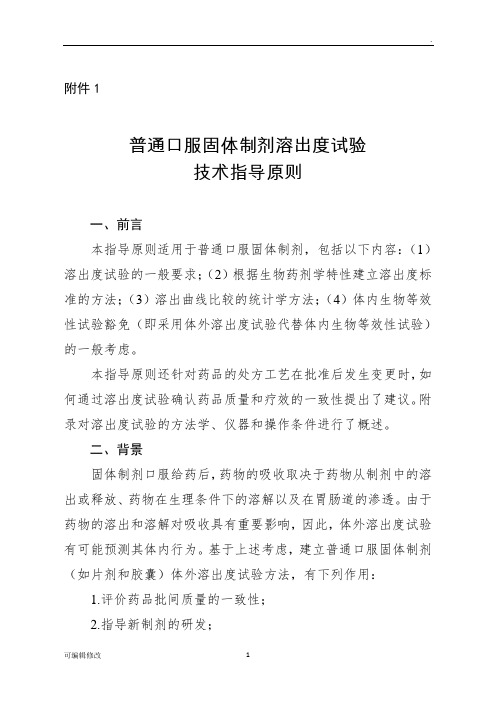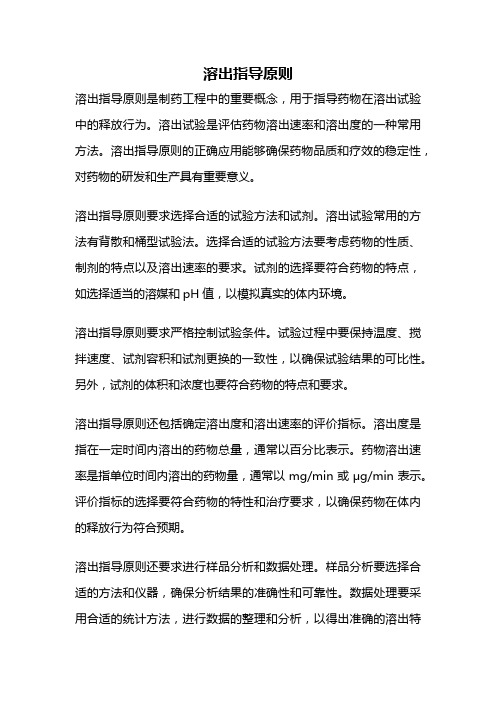FDA-溶出度指导原则
溶出度指导原则

附件1普通口服固体制剂溶出度试验技术指导原则一、前言本指导原则适用于普通口服固体制剂,包括以下内容:(1)溶出度试验的一般要求;(2)根据生物药剂学特性建立溶出度标准的方法;(3)溶出曲线比较的统计学方法;(4)体内生物等效性试验豁免(即采用体外溶出度试验代替体内生物等效性试验)的一般考虑。
本指导原则还针对药品的处方工艺在批准后发生变更时,如何通过溶出度试验确认药品质量和疗效的一致性提出了建议。
附录对溶出度试验的方法学、仪器和操作条件进行了概述。
二、背景固体制剂口服给药后,药物的吸收取决于药物从制剂中的溶出或释放、药物在生理条件下的溶解以及在胃肠道的渗透。
由于药物的溶出和溶解对吸收具有重要影响,因此,体外溶出度试验有可能预测其体内行为。
基于上述考虑,建立普通口服固体制剂(如片剂和胶囊)体外溶出度试验方法,有下列作用:1.评价药品批间质量的一致性;2.指导新制剂的研发;3.在药品发生某些变更后(如处方、生产工艺、生产场所变更和生产工艺放大),确认药品质量和疗效的一致性。
在药品批准过程中确定溶出度标准时,应考虑到药物的溶解性、渗透性、溶出行为及药代动力学特性等因素,以保证药品批间质量的一致性、变更以及工艺放大前后药品质量的一致性。
对于新药申请,应提供关键临床试验和/或生物利用度试验用样品以及其他人体试验用样品的体外溶出度数据。
对于仿制药申请,应在溶出曲线研究的基础上制定溶出度标准。
无论是新药还是仿制药申请,均应根据可接受的临床试验用样品、生物利用度和/或生物等效性试验用样品的溶出度结果,制定溶出度标准。
三、生物药剂学分类系统根据药物的溶解性和渗透性,推荐以下生物药剂学分类系统(BCS)(Amidon 1995):1类:高溶解性–高渗透性药物2类:低溶解性–高渗透性药物3类:高溶解性–低渗透性药物4类:低溶解性–低渗透性药物上述分类原则可作为制定体外溶出度质量标准的依据,也可用于预测能否建立良好的体内-体外相关性(IVIVC)。
溶出度指导原则

附件1普通口服固体制剂溶出度试验技术指导原则一、前言本指导原则适用于普通口服固体制剂,包括以下内容:(1)溶出度试验得一般要求;(2)根据生物药剂学特性建立溶出度标准得方法;(3)溶出曲线比较得统计学方法;(4)体内生物等效性试验豁免(即采用体外溶出度试验代替体内生物等效性试验)得一般考虑。
本指导原则还针对药品得处方工艺在批准后发生变更时,如何通过溶出度试验确认药品质量与疗效得一致性提出了建议。
附录对溶出度试验得方法学、仪器与操作条件进行了概述、二、背景固体制剂口服给药后,药物得吸收取决于药物从制剂中得溶出或释放、药物在生理条件下得溶解以及在胃肠道得渗透。
由于药物得溶出与溶解对吸收具有重要影响,因此,体外溶出度试验有可能预测其体内行为。
基于上述考虑,建立普通口服固体制剂(如片剂与胶囊)体外溶出度试验方法,有下列作用:1、评价药品批间质量得一致性;2.指导新制剂得研发;3。
在药品发生某些变更后(如处方、生产工艺、生产场所变更与生产工艺放大),确认药品质量与疗效得一致性。
在药品批准过程中确定溶出度标准时,应考虑到药物得溶解性、渗透性、溶出行为及药代动力学特性等因素,以保证药品批间质量得一致性、变更以及工艺放大前后药品质量得一致性。
对于新药申请,应提供关键临床试验与/或生物利用度试验用样品以及其她人体试验用样品得体外溶出度数据、对于仿制药申请,应在溶出曲线研究得基础上制定溶出度标准。
无论就是新药还就是仿制药申请,均应根据可接受得临床试验用样品、生物利用度与/或生物等效性试验用样品得溶出度结果,制定溶出度标准、三、生物药剂学分类系统根据药物得溶解性与渗透性,推荐以下生物药剂学分类系统(BCS)(Amidon 1995):1类:高溶解性–高渗透性药物2类:低溶解性–高渗透性药物3类:高溶解性–低渗透性药物4类:低溶解性–低渗透性药物上述分类原则可作为制定体外溶出度质量标准得依据,也可用于预测能否建立良好得体内-体外相关性(IVIVC)。
溶出度指导原则范文

溶出度指导原则范文
一、溶出度概念
溶出度是指溶剂中溶解的物质的物质在指定条件下,按质量计结果在
份数计算的百分比。
它是用来衡量溶样中物质的数量,反映溶样的质量及
可溶性。
溶出度主要包括离子溶出度和游离溶出度。
二、溶出度指导原则
1、避免采用过多的溶剂。
溶液浓度过大可能会溶解容器,导致样品
损失。
2、避免掺加太多溶剂改变产品的浓度,以免影响测定结果的准确性。
3、避免在温度较低的情况下进行溶解,以免减缓溶解过程,以节省
溶解时间及节约能源。
4、避免在温度较高的情况下进行溶解,以避免反应产物的挥发、氧化,影响测定结果的准确性。
5、避免采用溶剂和样品之间有反应的溶剂,如过氧化氢对苯基物质
有氧化作用。
6、避免在无容器的情况下单独溶解样品。
溶解容器可以防止样品挥
发及污染,保持溶解剂的稳定性。
7、避免使用过多的溶剂,以免影响溶出度,增加费用支出。
8、不要在溶解过程中直接加热,而是使用间歇加热的方法,以保证
溶解和溶出度的一致性。
9、使用恒功率加热,以节省加热时间,加快溶解速率,提高溶出度。
10、控制溶剂、溶解温度、溶解剂量,以优化溶出度。
溶出实验指导原则

附件1普通口服固体制剂溶出度试验技术指导原则一、前言本指导原则适用于普通口服固体制剂,包括以下内容:(1)溶出度试验的一般要求;(2)根据生物药剂学特性建立溶出度标准的方法;(3)溶出曲线比较的统计学方法;(4)体内生物等效性试验豁免(即采用体外溶出度试验代替体内生物等效性试验)的一般考虑。
本指导原则还针对药品的处方工艺在批准后发生变更时,如何通过溶出度试验确认药品质量和疗效的一致性提出了建议。
附录对溶出度试验的方法学、仪器和操作条件进行了概述。
二、背景固体制剂口服给药后,药物的吸收取决于药物从制剂中的溶出或释放、药物在生理条件下的溶解以及在胃肠道的渗透。
由于药物的溶出和溶解对吸收具有重要影响,因此,体外溶出度试验有可能预测其体内行为。
基于上述考虑,建立普通口服固体制剂(如片剂和胶囊)体外溶出度试验方法,有下列作用:1.评价药品批间质量的一致性;2.指导新制剂的研发;3.在药品发生某些变更后(如处方、生产工艺、生产场所变更和生产工艺放大),确认药品质量和疗效的一致性。
在药品批准过程中确定溶出度标准时,应考虑到药物的溶解性、渗透性、溶出行为及药代动力学特性等因素,以保证药品批间质量的一致性、变更以及工艺放大前后药品质量的一致性。
对于新药申请,应提供关键临床试验和/或生物利用度试验用样品以及其他人体试验用样品的体外溶出度数据。
对于仿制药申请,应在溶出曲线研究的基础上制定溶出度标准。
无论是新药还是仿制药申请,均应根据可接受的临床试验用样品、生物利用度和/或生物等效性试验用样品的溶出度结果,制定溶出度标准。
三、生物药剂学分类系统根据药物的溶解性和渗透性,推荐以下生物药剂学分类系统(BCS)(Amidon 1995):1类:高溶解性–高渗透性药物2类:低溶解性–高渗透性药物3类:高溶解性–低渗透性药物4类:低溶解性–低渗透性药物上述分类原则可作为制定体外溶出度质量标准的依据,也可用于预测能否建立良好的体内-体外相关性(IVIVC)。
美国药典溶出度试验方法的建立与验证指导原则的解读

小结
➢注重实操,关注细节。 ➢认真验证,数据为优。 ➢逻辑缜密,有理有节。 ➢宽容有度,得心应手。
重点关注
1、溶出的目的 2、造成溶出差异的因素
➢ 样品(是我们想知道,想找出的) ➢ 试验(是不想要的,应降到最低)
3、目测检视 4、方法学验证
谢谢!
溶出度与释放度的方法学验证
准确度
溶液稳 定性
专属性
验证 项目
耐用性
线性范 围
精密度
测定方法与验证-方法学验证
专属性
胶囊
辅料与其他 活性成分
沉降篮
干扰来自何方?如何除去干扰?
测定方法与验证-方法学验证
专属性应注意的问题
• 空白包括:其他活性成分(复方制剂中)、 辅料、包衣、油墨、沉降篮、胶囊壳、装 置(桨、杆、篮)等。
自动取 样
对比验证 内容
试验设计
取样应注意的问题
➢ 手动取样与自动取样要进行比较验证 ➢ 自动取样应注意日常性能检查和维护 ➢ 自动取样的装置要注意对溶出杯中流体力学的
干扰。 ➢ 自动取样的验证还包括:
残留药物的扣减 药物的吸附 洗涤或循环洗涤
试验设计
滤膜吸附及验证
滤过与离心
滤膜吸附的考察
滤膜吸附的验证
美国药典溶出度试验 方法的建立与验证指
导原则的解读
2017.6.30
涵盖内容
▪ 总体评价 ▪ 溶出介质 ▪ 溶出仪器 ▪ 实验设计 ▪ 测定方法与验证
总体评价
限度 范围
区分 力
总体 评价
稳定 性
变异 范围
总体评价-限度
▪ 限度范围应考虑的问题
1、多批次的考量 2、具有代表性 3、具有针对性(针对重点药品) 4、考虑样品的稳定性
溶出指导原则

附件1普通口服固体制剂溶出度试验技术指导原则一、前言本指导原则适用于普通口服固体制剂,包括以下内容:(1)溶出度试验的一般要求;(2)根据生物药剂学特性建立溶出度标准的方法;(3)溶出曲线比较的统计学方法;(4)体内生物等效性试验豁免(即采用体外溶出度试验代替体内生物等效性试验)的一般考虑。
本指导原则还针对药品的处方工艺在批准后发生变更时,如何通过溶出度试验确认药品质量和疗效的一致性提出了建议。
附录对溶出度试验的方法学、仪器和操作条件进行了概述。
二、背景固体制剂口服给药后,药物的吸收取决于药物从制剂中的溶出或释放、药物在生理条件下的溶解以及在胃肠道的渗透。
由于药物的溶出和溶解对吸收具有重要影响,因此,体外溶出度试验有可能预测其体内行为。
基于上述考虑,建立普通口服固体制剂(如片剂和胶囊)体外溶出度试验方法,有下列作用:1.评价药品批间质量的一致性;2.指导新制剂的研发;3.在药品发生某些变更后(如处方、生产工艺、生产场所变更和生产工艺放大),确认药品质量和疗效的一致性。
在药品批准过程中确定溶出度标准时,应考虑到药物的溶解性、渗透性、溶出行为及药代动力学特性等因素,以保证药品批间质量的一致性、变更以及工艺放大前后药品质量的一致性。
对于新药申请,应提供关键临床试验和/或生物利用度试验用样品以及其他人体试验用样品的体外溶出度数据。
对于仿制药申请,应在溶出曲线研究的基础上制定溶出度标准。
无论是新药还是仿制药申请,均应根据可接受的临床试验用样品、生物利用度和/或生物等效性试验用样品的溶出度结果,制定溶出度标准。
三、生物药剂学分类系统根据药物的溶解性和渗透性,推荐以下生物药剂学分类系统(BCS)(Amidon 1995):1类:高溶解性–高渗透性药物2类:低溶解性–高渗透性药物3类:高溶解性–低渗透性药物4类:低溶解性–低渗透性药物上述分类原则可作为制定体外溶出度质量标准的依据,也可用于预测能否建立良好的体内-体外相关性(IVIVC)。
fda 溶出度指导原则

fda 溶出度指导原则溶出度是指药物从片剂、胶囊剂等固体制剂在规定溶剂中溶出的速度和程度。
溶出度是评价药品质量的重要指标之一,也是FDA进行药品审评的重要内容之一。
本指导原则旨在提供关于溶出度试验的基本原则和方法,以确保药品的质量和安全性。
溶出度试验的目的溶出度试验的主要目的是评估药品在体内吸收的有效性和安全性。
通过溶出度试验,可以了解药物在体内的释放行为,预测药物的生物利用度和药效学性质。
此外,溶出度试验还可以用于比较不同制剂的差异,以确保药品的质量和稳定性。
溶出度试验的方法1. 仪器:使用符合标准的溶出度测定仪,能够准确地测量药物的溶出度。
2. 溶剂:使用规定的溶剂,如水、缓冲液或模拟胃液等。
3. 样品:取适量的药品制剂,按照规定的条件进行试验。
4. 试验条件:试验条件应符合药品审评的相关规定,如转速、温度、介质等。
5. 分析方法:使用合适的方法对药物进行分析,如高效液相色谱法、紫外可见分光光度法等。
溶出度试验的结果分析1. 数据处理:对试验数据进行处理和分析,计算药物的溶出度数据。
2. 结果评估:根据溶出度数据评估药品的质量和安全性。
如果药物的溶出度不符合规定,需要对生产工艺进行调整或改进。
3. 文件记录:对试验过程和结果进行详细记录,并整理成完整的报告,以便于药品审评和管理。
溶出度试验的注意事项1. 试验前应对仪器进行校准和维护,确保设备的准确性和可靠性。
2. 严格遵守试验条件,不得随意更改或调整。
3. 在试验过程中应注意观察和记录异常情况,及时进行处理和报告。
4. 试验结束后应对样品进行妥善处理和保存,以便于后续分析和研究。
溶出度试验是评价药品质量的重要方法之一,对于确保药品的安全性和有效性具有重要意义。
本指导原则提供了关于溶出度试验的基本原则和方法,旨在帮助制药企业进行药品研发和质量控制。
在进行溶出度试验时,应遵守相关法规和指导原则,确保试验的准确性和可靠性。
同时,应关注试验过程中的细节和注意事项,确保试验结果的准确性和可重复性。
溶出度指导原则001讲解

4.计算受试和参比样品拟合模型参数的MSD(多变量统计矩)。
5.确定受试与参比样品间溶出差异的90%置信区间。
6.比较置信区间与相似性限度。如果置信区间落在相似性限度内,可认为受试与 参比样品具有相似的溶出曲线。
普通口服固体制剂上市后变更的溶出度研究 处方变更,建议在多种介质中进行溶出比较试验。 生产场所的变更、放大设备变更和较小的工艺变更,溶出度试验应足以确认产品 质量和性能是否有改变。推荐采用非模型依赖相似因子(f2)方法进行溶出度的 对比研究,以确认变更前后产品质量是否一致。
溶出曲线的比较
采用非模型依赖法或模型依赖方法进行溶出曲线的比较。 (一)非模型依赖法 1. 非模型依赖的相似因子法 采用差异因子(f1)或相似因子(f2)来比较溶出曲线是一种简单的非模型依赖 方法。差异因子(f1)法是计算两条溶出曲线在每一时间点的差异(%),是衡 量两条曲线相对偏差的参数,计算公式如下:
3.测定这些受试样品的生物利用度及体内外关系。
采用绘图方法确定的药品溶出度标准可更好地确保稳定的药品质量和性能。根据 研究的样品数,绘图研究可提供体内外相关性信息和/或体内数据与体外数据间 的关系。
溶出度标准的建立
体内-体外相关性 1)通过体外溶出度测定就可区分合格和不合格的产品。溶出度合格的产品应是 体内生物等效的产品,而不合格的产品则不具有生物等效性。
溶出度标准的建立
绘图或效应面优化法 绘图法是确定关键生产变量(CMV)与体外溶出曲线及体内生物利用度数据效 应面之间相关性关系的过程。该方法的目的是制定科学、合理的溶出度标准,保 证符合标准的药品具有生物等效性。 1.采用不同的关键生产参数制备两个或更多的样品制剂,并研究其体外溶出特征。
溶出指导原则

溶出指导原则溶出指导原则是制药工程中的重要概念,用于指导药物在溶出试验中的释放行为。
溶出试验是评估药物溶出速率和溶出度的一种常用方法。
溶出指导原则的正确应用能够确保药物品质和疗效的稳定性,对药物的研发和生产具有重要意义。
溶出指导原则要求选择合适的试验方法和试剂。
溶出试验常用的方法有背散和桶型试验法。
选择合适的试验方法要考虑药物的性质、制剂的特点以及溶出速率的要求。
试剂的选择要符合药物的特点,如选择适当的溶媒和pH值,以模拟真实的体内环境。
溶出指导原则要求严格控制试验条件。
试验过程中要保持温度、搅拌速度、试剂容积和试剂更换的一致性,以确保试验结果的可比性。
另外,试剂的体积和浓度也要符合药物的特点和要求。
溶出指导原则还包括确定溶出度和溶出速率的评价指标。
溶出度是指在一定时间内溶出的药物总量,通常以百分比表示。
药物溶出速率是指单位时间内溶出的药物量,通常以mg/min或μg/min表示。
评价指标的选择要符合药物的特性和治疗要求,以确保药物在体内的释放行为符合预期。
溶出指导原则还要求进行样品分析和数据处理。
样品分析要选择合适的方法和仪器,确保分析结果的准确性和可靠性。
数据处理要采用合适的统计方法,进行数据的整理和分析,以得出准确的溶出特性和释放行为。
在应用溶出指导原则时,还需要注意以下几个方面。
首先,要遵循国家和行业的相关规范和标准,确保试验的可靠性和可比性。
其次,要进行充分的前期研究和试验验证,确定合适的试验方法和条件。
最后,要进行溶出曲线的拟合和模型的建立,以预测和优化药物的溶出行为。
溶出指导原则是制药工程中重要的原则和方法,能够指导药物的溶出试验和释放行为的评价。
正确应用溶出指导原则可以提高药物的研发和生产效率,确保药物的质量和疗效稳定性,对于制药行业具有重要意义。
溶出度与释放度方法应用指导原则

例5 取本品,照溶出度测定法(附录X C第一 法),以磷酸盐缓冲液( pH7.2 ) 900ml 为溶 出介质,转速为每分钟 120转,依法操作,经 30 分钟时,取溶液 10ml ,滤过,取续滤液作 为供试品溶液。照含量测定项下的方法测定, 计算每片中布洛芬与盐酸伪麻黄碱的溶出量。 限度为标示量的80%,应符合规定。 (布洛伪麻片)
另取尼莫地平对照品约 10mg ,精密称定,置 100ml量瓶中,加乙醇10ml,振摇使溶解,加 溶出介质稀释至刻度,摇匀,精密量取5ml, 置 50ml 量瓶中,加溶出介质稀释至刻度,摇 匀,作为对照品溶液。分别取供试品溶液与 对照品溶液,照紫外-可见分光光度法(附 录Ⅳ A),在238nm的波长处分别测定吸光度, 计算每片的溶出量。限度为标示量的 85% , 应符合规定。 (尼莫地平分散片)
6. 溶出介质的体积一般应符合漏槽条件。
7. 应注意胶囊壳对测定产生干扰的可能性,应 取同批不少于6粒的空胶囊(或尽可能完全除尽 内容物的空胶囊),置同一溶出杯内,用溶出条 件下同样体积的溶出介质溶解空胶囊壳,并按溶 出试验同样的分析方法测定,折合成每个空胶囊 的空白值,作必要的校正。校正值不得大于标示 量的25%。如校正值不大于 1.标示量的2%,可 忽略不计。 拟用加酶法测定溶出度时,首先应有符合溶出 度测定要求的试剂酶,对试剂酶应有活力和纯度 要求,其空白校正值应控制在一定范围内。
例6 取本品,照溶出度测定法(附录X C第二 法),以磷酸盐缓冲液( pH5.8 ) 900ml 为溶 出介质,转速为每分钟 50 转,依法操作,经 30 分钟时,取溶液适量,滤过,取续滤液作 为供试品溶液。精密量取含量测定项下的对 照品溶液5ml,置50ml量瓶中,加溶出介质稀 释至刻度,摇匀,作为对照品溶液。取上述 两种溶液,照含量测定项下的色谱条件测定, 分别计算每片呋塞米与盐酸阿米洛利的溶出 量。限度均为标示量的75%,应符合规定。 (复方呋塞米片)
溶出度指导原则

附件 1普通口服固体制剂溶出度试验技术指导原则一、前言本指导原则适用于普通口服固体制剂,包括以下内容:(1)溶出度试验的一般要求;(2)根据生物药剂学特性建立溶出度标准的方法;(3)溶出曲线比较的统计学方法;(4)体内生物等效性试验豁免(即采用体外溶出度试验代替体内生物等效性试验)的一般考虑。
本指导原则还针对药品的处方工艺在批准后发生变更时,如何通过溶出度试验确认药品质量和疗效的一致性提出了建议。
附录对溶出度试验的方法学、仪器和操作条件进行了概述。
二、背景固体制剂口服给药后,药物的吸收取决于药物从制剂中的溶出或释放、药物在生理条件下的溶解以及在胃肠道的渗透。
由于药物的溶出和溶解对吸收具有重要影响,因此,体外溶出度试验有可能预测其体内行为。
基于上述考虑,建立普通口服固体制剂(如片剂和胶囊)体外溶出度试验方法,有下列作用:1.评价药品批间质量的一致性;2.指导新制剂的研发;3.在药品发生某些变更后(如处方、生产工艺、生产场所变更和生产工艺放大),确认药品质量和疗效的一致性。
在药品批准过程中确定溶出度标准时,应考虑到药物的溶解性、渗透性、溶出行为及药代动力学特性等因素,以保证药品批间质量的一致性、变更以及工艺放大前后药品质量的一致性。
对于新药申请,应提供关键临床试验和/或生物利用度试验用样品以及其他人体试验用样品的体外溶出度数据。
对于仿制药申请,应在溶出曲线研究的基础上制定溶出度标准。
无论是新药还是仿制药申请,均应根据可接受的临床试验用样品、生物利用度和/或生物等效性试验用样品的溶出度结果,制定溶出度标准。
三、生物药剂学分类系统根据药物的溶解性和渗透性,推荐以下生物药剂学分类系统(BCS)(Amidon 1995):1类:高溶解性–高渗透性药物2类:低溶解性–高渗透性药物3类:高溶解性–低渗透性药物4类:低溶解性–低渗透性药物上述分类原则可作为制定体外溶出度质量标准的依据,也可用于预测能否建立良好的体内-体外相关性(IVIVC)。
口服固体制剂溶出度试验技术指导原则

口服固体制剂溶出度试验技术指导原则1997年8月 美国FDA发布2009年6月 药审中心组织翻译苏威制药公司翻译北核协会审核药审中心最终核准目 录Ⅰ. 前言 (1)Ⅱ. 背景 (1)Ⅲ. 生物药剂学分类系统 (2)Ⅳ. 建立溶出度质量标准 (3)A. 建立新化学实体溶出度质量标准的方法 (4)B. 建立仿制药品溶出度质量标准的方法 (5)C. 特例 (5)D. 绘图或效应面优化法 (6)E. 体内-体外相关性 (6)F. 质量标准的验证和证实 (7)Ⅴ. 溶出曲线比较 (7)A. 模型非依赖性相似因子方法 (7)B. 模型非依赖性多变量置信区域方法 (9)C. 模型依赖性方法 (9)Ⅵ. 溶出度与SUPAC-IR (9)Ⅶ. 体内生物试验的豁免 (10)附录A口服固体制剂溶出度试验技术指导原则Ⅰ. 前言本指南适用于普通口服固体(Immediate release,IR)剂型,可提供以下内容:(1)溶出度试验的一般建议;(2)设定与药物生物药剂学特性相关的溶出度质量标准的方法;(3)比较溶出度曲线的统计学方法;(4)协助确定在何种情况下溶出度试验足以证明可以豁免体内生物等效性研究的方法。
本文还针对药品在批准后生产工艺发生变更时,溶出度试验在确保药品质量和疗效一致性方面的建议。
附录A以摘要形式概述了溶出度试验的方法学、仪器和操作条件。
本指南的目的旨在通过提供获得溶出度比较曲线的参考意见,以完善SUPAC–IR行业指南;普通口服固体制剂;工艺放大和批准后变更;化学、生产和控制;体外溶出度试验和体内生物等效性研究的文档管理。
Ⅱ.背景固体制剂口服给药后,药物的吸收取决于药物由制剂中的释放、生理条件下药物的溶出度或溶解作用及药物在胃肠道的生物膜通透性。
上述步骤中由于前两步具有决定作用,因此药物的体外溶出度有可能预测体内行为。
基于这些基本的考虑,口服速释固体制剂,如片剂和胶囊,其体外溶出度试验可用于(1)评价制剂批间质量的一致性;(2)指导新制剂的开发;(3)产品发生某些变更后,如处方、生产工艺、生产场所变更和生产工艺放大后,确保药品质量和疗效的一致性。
fda对于溶出曲线区分力的要求

文章标题:深度解析FDA对于溶出曲线区分力的要求一、概述FDA(Food and Drug Administration)对于药物溶出曲线的要求是制药行业中非常重要的一环。
溶出曲线是评价固体制剂中活性成分释放行为的重要指标,也是判断药物质量和疗效的重要依据之一。
其中,溶出曲线区分力是评价药物溶出度和释放行为是否符合要求的重要参数之一。
本文将通过深入探讨FDA对于溶出曲线区分力的要求,帮助读者全面了解并掌握该知识。
二、FDA对于溶出曲线区分力的要求1. 医药制剂技术指南FDA在《医药制剂技术指南》中对药物溶出曲线的要求进行了详细规定,明确指出了溶出曲线的区分力要求。
根据该指南,溶出曲线的区分力应能够准确反映出不同制剂或不同批次之间的差异,以便对药物质量进行评估和监控。
区分力越高,表示溶出曲线能够更好地区分出不同制剂或不同批次之间的差异,提高了监测的准确性和可靠性。
2. 参数要求FDA要求药物溶出曲线的区分力应当符合一定的参数要求,包括但不限于峰高度、峰面积、对比度等。
这些参数能够直观地表征溶出曲线的陡峭程度、峰形态等特征,从而影响区分力的大小。
具体要求可以根据不同药物的特性和适用性进行调整,但都应符合FDA规定的标准。
三、个人观点和理解我个人认为,FDA对于溶出曲线区分力的要求非常严格和必要。
高区分力的溶出曲线能够更好地展现出药物释放行为的差异性,有利于更准确地评估药物的质量和疗效。
对溶出曲线的区分力要求也促进了制药行业的规范化和标准化发展,有利于提高制药产品质量和安全性。
四、总结通过本文的深度解析,我们全面了解了FDA对于溶出曲线区分力的要求。
溶出曲线作为评价固体制剂中活性成分释放行为的重要指标,其区分力对药物质量和疗效具有重要影响。
了解并掌握FDA的相关要求,可以帮助制药行业更好地开展质量控制和监测工作,提高药物质量和疗效的保障。
在文章中多次提及:FDA、溶出曲线、区分力总字数:4263希望这篇文章能够满足你的要求,如果需要调整或补充内容,欢迎指示。
溶出度指导原则

附件1之老阳三干创作普通口服固体制剂溶出度试验技术指导原则一、前言本指导原则适用于普通口服固体制剂,包含以下内容:(1)溶出度试验的一般要求;(2)根据生物药剂学特性建立溶出度尺度的方法;(3)溶出曲线比较的统计学方法;(4)体内生物等效性试验豁免(即采取体外溶出度试验代替体内生物等效性试验)的一般考虑。
本指导原则还针对药品的处方工艺在批准后发生变动时,如何通过溶出度试验确认药品质量和疗效的一致性提出了建议。
附录对溶出度试验的方法学、仪器和操纵条件进行了概述。
二、布景固体制剂口服给药后,药物的吸收取决于药物从制剂中的溶出或释放、药物在生理条件下的溶解以及在胃肠道的渗透。
由于药物的溶出和溶解对吸收具有重要影响,因此,体外溶出度试验有可能预测其体内行为。
基于上述考虑,建立普通口服固体制剂(如片剂和胶囊)体外溶出度试验方法,有下列作用:1.评价药品批间质量的一致性;2.指导新制剂的研发;3.在药品发生某些变动后(如处方、生产工艺、生产场合变动和生产工艺放大),确认药品质量和疗效的一致性。
在药品批准过程中确定溶出度尺度时,应考虑到药物的溶解性、渗透性、溶出行为及药代动力学特性等因素,以包管药品批间质量的一致性、变动以及工艺放大前后药品质量的一致性。
对于新药申请,应提供关键临床试验和/或生物利用度试验用样品以及其他人体试验用样品的体外溶出度数据。
对于仿制药申请,应在溶出曲线研究的基础上制定溶出度尺度。
无论是新药还是仿制药申请,均应根据可接受的临床试验用样品、生物利用度和/或生物等效性试验用样品的溶出度结果,制定溶出度尺度。
三、生物药剂学分类系统根据药物的溶解性和渗透性,推荐以下生物药剂学分类系统(BCS)(Amidon 1995):1类:高溶解性–高渗透性药物2类:低溶解性–高渗透性药物3类:高溶解性–低渗透性药物4类:低溶解性–低渗透性药物上述分类原则可作为制定体外溶出度质量尺度的依据,也可用于预测能否建立良好的体内-体外相关性(IVIVC)。
溶出度指导原则

普通口服固体制剂溶出曲线测定与比较指导原则(2015-11-09 16:15:30)转载▼分类:仿制药质量一致性评价工作方案普通口服固体制剂溶出曲线测定与比较指导原则一、概述为进一步推进仿制药与原研药品质量和疗效一致性评价工作的开展,根据《国务院关于改革药品医疗器械审评审批制度的意见》(国发〔2015〕44号)要求,制定本指导原则。
本指导原则适用于仿制药质量一致性评价中普通口服固体制剂溶出曲线测定方法的建立和溶出曲线相似性的比较。
二、背景固体制剂口服给药后,药物的吸收取决于药物从制剂中的溶出或释放、药物在生理条件下的溶解以及在胃肠道的渗透等,因此,药物的体内溶出和溶解对吸收具有重要影响。
体外溶出试验常用于指导药物制剂的研发、评价制剂批内批间质量的一致性、评价药品处方工艺变更前后质量和疗效的一致性等。
普通口服固体制剂,可采用比较仿制制剂与参比制剂体外多条溶出曲线相似性的方法,评价仿制制剂的质量。
溶出曲线的相似并不意味着两者一定具有生物等效,但该法可降低两者出现临床疗效差异的风险。
三、溶出试验方法的建立溶出试验方法应能客观反映制剂特点、具有适当的灵敏度和区分力。
可参考有关文献,了解药物的溶解性、渗透性、pKa常数等理化性质,考察溶出装置、介质、搅拌速率和取样间隔期等试验条件,确定适宜的试验方法。
(一)溶出仪溶出仪需满足相关的技术要求,应能够通过机械验证及性能验证试验。
必要时,可对溶出仪进行适当改装,但需充分评价其必要性和可行性。
溶出试验推荐使用桨法、篮法,一般桨法选择50~75转/分钟,篮法选择50~100转/分钟。
在溶出试验方法建立的过程中,转速的选择推荐由低到高。
若转速超出上述规定应提供充分说明。
(二)溶出介质溶出介质的研究应根据药物的性质,充分考虑药物在体内的环境,选择多种溶出介质进行,必要时可考虑加入适量表面活性剂、酶等添加物。
1.介质的选择应考察药物在不同pH值溶出介质中的溶解度,推荐绘制药物的pH-溶解度曲线。
溶出度指导原则

附件1普通口服固体制剂溶出度试验技术指导原则一、前言本指导原则适用于普通口服固体制剂,包括以下内容:(1)溶出度试验的一般要求;(2)根据生物药剂学特性建立溶出度标准的方法;(3)溶出曲线比较的统计学方法;(4)体内生物等效性试验豁免(即采用体外溶出度试验代替体内生物等效性试验)的一般考虑。
本指导原则还针对药品的处方工艺在批准后发生变更时,如何通过溶出度试验确认药品质量和疗效的一致性提出了建议。
附录对溶出度试验的方法学、仪器和操作条件进行了概述。
二、背景固体制剂口服给药后,药物的吸收取决于药物从制剂中的溶出或释放、药物在生理条件下的溶解以及在胃肠道的渗透。
由于药物的溶出和溶解对吸收具有重要影响,因此,体外溶出度试验有可能预测其体内行为。
基于上述考虑,建立普通口服固体制剂(如片剂和胶囊)体外溶出度试验方法,有下列作用:1.评价药品批间质量的一致性;2.指导新制剂的研发;3.在药品发生某些变更后(如处方、生产工艺、生产场所变更和生产工艺放大),确认药品质量和疗效的一致性。
在药品批准过程中确定溶出度标准时,应考虑到药物的溶解性、渗透性、溶出行为及药代动力学特性等因素,以保证药品批间质量的一致性、变更以及工艺放大前后药品质量的一致性。
对于新药申请,应提供关键临床试验和/或生物利用度试验用样品以及其他人体试验用样品的体外溶出度数据。
对于仿制药申请,应在溶出曲线研究的基础上制定溶出度标准。
无论是新药还是仿制药申请,均应根据可接受的临床试验用样品、生物利用度和/或生物等效性试验用样品的溶出度结果,制定溶出度标准。
三、生物药剂学分类系统根据药物的溶解性和渗透性,推荐以下生物药剂学分类系统(BCS)(Amidon 1995):1类:高溶解性–高渗透性药物2类:低溶解性–高渗透性药物3类:高溶解性–低渗透性药物4类:低溶解性–低渗透性药物上述分类原则可作为制定体外溶出度质量标准的依据,也可用于预测能否建立良好的体内-体外相关性(IVIVC)。
溶出度与释放度方法应用指导原则

3. 溶出方法的选择;主要有第一法 (转篮法)、第二法(桨法)和第三法 (小杯法)。 小杯法主要用于在转篮法和桨法条件 下,溶出液的浓度过稀,即使采用较灵 敏的方法(如UV法使用长光路吸收池等) 仍难以进行定量测定的品种。 转篮法和桨法的选择,一般可参照下 列原则:
(1) 对于非崩解型药物,用转篮法较好。 ( 2 ) 对于崩解型药物,在进行转篮法的整个过 程中,确保转篮网孔的通透性尤为重要,对于 处方中辅料或主药影响转篮通透性的固体制剂, 一般采用桨法。同理,制剂中若含有一定的胶 性物质,一般不宜用转篮法。 ( 3 ) 制剂中含有难以溶解,扩散的成分,选 桨法比转篮法好。 ( 4 ) 对于漂浮于液面的制剂,如果辅料不堵塞 网孔,应选用转篮法。否则,选用桨法并将供 试品放入沉降篮中,并在正文中加以规定。但 采用小杯法时不能使用沉降篮。
书写格式举例如下。 例1 取本品,照溶出度测定法(附录X C第一 法),以水 1000ml 为溶出介质,转速为每分 钟 100 转,依法操作,经 30 分钟时,取溶液 5ml滤过,精密量取续滤液适量,用水定量稀 释制成每 1ml中含10~20 μ g的溶液,照紫外 -可见分光光度法(附录Ⅳ A),在263nm的 波长处测定吸光度 ,按 C6H7N3O 的吸收系数 ( E1%1cm )为307计算每片的溶出量。限度为 标示量的60%,应符合规定。 (异烟肼片)
缓释制剂释药曲线的累积释放量一般应大 于标示量的90%, 从释药曲线图中至少选出 5 个取样时间点, 同时应根据给药时间间隔不同,适当增加取 样点。 一般第一个取样点为 0.5~1 小时,用于考察 药物是否有突释,中间取样时间点,用于确 定释药特性,最后的取样时间点,用于考察 释药是否基本完全。控释制剂,较全面地考 察体外药物恒速或几乎恒速释放情况。
- 1、下载文档前请自行甄别文档内容的完整性,平台不提供额外的编辑、内容补充、找答案等附加服务。
- 2、"仅部分预览"的文档,不可在线预览部分如存在完整性等问题,可反馈申请退款(可完整预览的文档不适用该条件!)。
- 3、如文档侵犯您的权益,请联系客服反馈,我们会尽快为您处理(人工客服工作时间:9:00-18:30)。
Q8 Pharmaceutical Development U.S. Department of Health and Human ServicesFood and Drug AdministrationCenter for Drug Evaluation and Research (CDER) Center for Biologics Evaluation and Research (CBER)May 2006ICHQ8 Pharmaceutical DevelopmentAdditional copies are available from:Office of Training and CommunicationDivision of Drug Information, HFD-240Center for Drug Evaluation and ResearchFood and Drug Administration5600 Fishers LaneRockville, MD 20857(Tel) 301-827-4573/cder/guidance/index.htmOffice of Communication, Training andManufacturers Assistance, HFM-40Center for Biologics Evaluation and ResearchFood and Drug Administration1401 Rockville Pike, Rockville, MD 20852-1448/cber/guidelines.htm.U.S. Department of Health and Human ServicesFood and Drug AdministrationCenter for Drug Evaluation and Research (CDER) Center for Biologics Evaluation and Research (CBER)May 2006ICHTABLE OF CONTENTSI.INTRODUCTION (1, 1.1) (1)II.PHARMACEUTICAL DEVELOPMENT (2) (2)ponents of the Drug Product (2.1) (3)1.Drug Substance (2.1.1) (3)2.Excipients (2.1.2) (4)B.Drug Product (2.2) (4)1.Formulation Development (2.2.1) (4)2.Overages (2.2.2) (5)3.Physicochemical and Biological Properties (2.2.3) (5)C.Manufacturing Process Development (2.3) (6)D.Container Closure System (2.4) (7)E.Microbiological Attributes (2.5) (7)patibility (2.6) (8)III.GLOSSARY (3) (9)Guidance for Industry1Q8 Pharmaceutical DevelopmentThis guidance represents the Food and Drug Administration's (FDA's) current thinking on this topic. It does not create or confer any rights for or on any person and does not operate to bind FDA or the public. You can use an alternative approach if the approach satisfies the requirements of the applicable statutes and regulations. If you want to discuss an alternative approach, contact the FDA staff responsible for implementing this guidance. If you cannot identify the appropriate FDA staff, call the appropriate number listed on the title page of this guidance.I. INTRODUCTION (1, 1.1)2This guidance describes the suggested contents for the 3.2.P.2 (Pharmaceutical Development) section of a regulatory submission in the ICH M4 Common Technical Document (CTD) format. The Pharmaceutical Development section provides an opportunity to present the knowledge gained through the application of scientific approaches and quality risk management (for definition, see ICH Q9 Quality Risk Management) to the development of a product and its manufacturing process. It is first produced for the original marketing application and can be updated to support new knowledge gained over the lifecycle3 of a product. The Pharmaceutical Development section is intended to provide a comprehensive understanding of the product and manufacturing process for reviewers and inspectors. The guidance also indicates areas where the demonstration of greater understanding of pharmaceutical and manufacturing sciences can create a basis for flexible regulatory approaches. The degree of regulatory flexibility is predicated on the level of relevant scientific knowledge provided.FDA's guidance documents, including this guidance, do not establish legally enforceable responsibilities. Instead, guidances describe the Agency's current thinking on a topic and should be viewed only as recommendations, unless specific regulatory or statutory requirements are1This guidance was developed within the Expert Working Group (Quality) of the International Conference on Harmonisation of Technical Requirements for Registration of Pharmaceuticals for Human Use (ICH) and has been subject to consultation by the regulatory parties, in accordance with the ICH process. This document has been endorsed by the ICH Steering Committee at Step 4 of the ICH process, November 2005. At Step 4 of the process, the final draft is recommended for adoption to the regulatory bodies of the European Union, Japan, and the United States.2 Arabic numbers reflect the organizational breakdown of the document endorsed by the ICH Steering Committee at Step 4 of the ICH process, November 2005.3 Terms that appear in bold italic type in this guidance are defined in the glossary, section III (3).cited. The use of the word should in Agency guidances means that something is suggested or recommended, but not required.Scope (1.2)This guidance is intended to provide guidance on the contents of section 3.2.P.2 (Pharmaceutical Development) for drug products as defined in the scope of Module 3 of the Common Technical Document (ICH M4:Common Technical Document for the Registration of Pharmaceuticals for Human Use). The guidance does not apply to contents of submissions for drug products during the clinical research stages of drug development. However, the principles in this guidance are important to consider during those stages as well. This guidance might also be appropriate for other types of products. To determine the applicability of this guidance to a particular type of product, applicants can consult with the appropriate regulatory authorities.II. PHARMACEUTICAL DEVELOPMENT (2)The aim of pharmaceutical development is to design a quality product and its manufacturing process to consistently deliver the intended performance of the product. The information and knowledge gained from pharmaceutical development studies and manufacturing experience provide scientific understanding to support the establishment of the design space, specifications, and manufacturing controls.Information from pharmaceutical development studies can be a basis for quality risk management. It is important to recognize that quality cannot be tested into products, i.e., quality should be built in by design. Changes in formulation and manufacturing processes during development and lifecycle management should be looked upon as opportunities to gain additional knowledge and further support establishment of the design space. Similarly, inclusion of relevant knowledge gained from experiments giving unexpected results can also be useful. Design space is proposed by the applicant and is subject to regulatory assessment and approval. Working within the design space is not considered as a change. Movement out of the design space is considered to be a change and would normally initiate a regulatory postapproval change process.The Pharmaceutical Development section should describe the knowledge that establishes that the type of dosage form selected and the formulation proposed are suitable for the intended use. This section should include sufficient information in each part to provide an understanding of the development of the drug product and its manufacturing process. Summary tables and graphs are encouraged where they add clarity and facilitate review.At a minimum, those aspects of drug substances, excipients, container closure systems, and manufacturing processes that are critical to product quality should be determined and control strategies justified. Critical formulation attributes and process parameters are generally identified through an assessment of the extent to which their variation can have impact on the quality of the drug product.In addition, the applicant can choose to conduct pharmaceutical development studies that can lead to an enhanced knowledge of product performance over a wider range of material attributes, processing options and process parameters. Inclusion of this additional information in the Pharmaceutical Development section provides an opportunity to demonstrate a higher degree of understanding of material attributes, manufacturing processes, and their controls. This scientific understanding facilitates establishment of an expanded design space. In these situations, opportunities exist to develop more flexible regulatory approaches, for example, to facilitate: •risk-based regulatory decisions (reviews and inspections)•manufacturing process improvements, within the approved design space described in the dossier, without further regulatory review•reduction of postapproval submissions•real-time quality control, leading to a reduction of end-product release testingTo realize this flexibility, the applicant should demonstrate an enhanced knowledge of product performance over a range of material attributes, manufacturing process options and process parameters. This understanding can be gained by application of, for example, formal experimental designs, process analytical technology (PAT), and/or prior knowledge. Appropriate use of quality risk management principles can be helpful in prioritizing the additional pharmaceutical development studies to collect such knowledge.The design and conduct of pharmaceutical development studies should be consistent with their intended scientific purpose. It should be recognized that the level of knowledge gained, and not the volume of data, provides the basis for science-based submissions and their regulatory evaluation.A. Components of the Drug Product (2.1)1. Drug Substance (2.1.1)The physicochemical and biological properties of the drug substance that can influence the performance of the drug product and its manufacturability, or were specifically designed into the drug substance (e.g., solid state properties), should be identified and discussed. Examples of physicochemical and biological properties that should be examined, as appropriate, include solubility, water content, particle size, crystal properties, biological activity, and permeability. These properties could be interrelated and, when appropriate, should be considered in combination.To evaluate the potential effect of drug substance physicochemical properties on the performance of the drug product, studies on drug product might be warranted. For example, ICH Q6A Specifications: Test Procedures and Acceptance Criteria for New Drug Substances and New Drug Products: Chemical Substances describes some of the circumstances in which drug product studies are recommended (e.g., Decision Trees #3 and #4 (Part 2)). This approach applies equally for ICH Q6B Specifications: Test Procedures and Acceptance Criteria forBiotechnology/Biological Products. The knowledge gained from the studies investigating thepotential effect of drug substance properties on drug product performance can be used, as appropriate, to justify elements of the drug substance specification (3.2.S.4.5).The compatibility of the drug substance with excipients listed in 3.2.P.1 should be evaluated. For products that contain more than one drug substance, the compatibility of the drug substances with each other should also be evaluated.(2.1.2)2. ExcipientsThe excipients chosen, their concentration, and the characteristics that can influence the drug product performance (e.g., stability, bioavailability) or manufacturability should be discussed relative to the respective function of each excipient. This should include all substances used in the manufacture of the drug product, whether they appear in the finished product or not (e.g., processing aids). Compatibility of excipients with other excipients, where relevant (for example, combination of preservatives in a dual preservative system), should be established. The ability of excipients (e.g., antioxidants, penetration enhancers, disintegrants, release controlling agents) to provide their intended functionality and to perform throughout the intended drug product shelf life should also be demonstrated. The information on excipient performance can be used, as appropriate, to justify the choice and quality attributes of the excipient and to support the justification of the drug product specification (3.2.P.5.6).Information to support the safety of excipients, when appropriate, should be cross-referenced (3.2.P.4.6).B. Drug Product (2.2)1. Formulation Development (2.2.1)A summary should be provided describing the development of the formulation, including identification of those attributes that are critical to the quality of the drug product, taking into consideration intended usage and route of administration. Information from formal experimental designs can be useful in identifying critical or interacting variables that might be important to ensure the quality of the drug product.The summary should highlight the evolution of the formulation design from initial concept up to the final design. This summary should also take into consideration the choice of drug product components (e.g., the properties of the drug substance, excipients, container closure system, any relevant dosing device), the manufacturing process, and, if appropriate, knowledge gained from the development of similar drug product(s).Any excipient ranges included in the batch formula (3.2.P.3.2) should be justified in the Pharmaceutical Development section of the application; this justification can often be based on the experience gained during development or manufacture.A summary of formulations used in clinical safety and efficacy and in any relevant bioavailability or bioequivalence studies should be provided. Any changes between the proposedcommercial formulation and those formulations used in pivotal clinical batches and primary stability batches should be clearly described and the rationale for the changes provided.Information from comparative in vitro studies (e.g., dissolution) or comparative in vivo studies (e.g., bioequivalence) that links clinical formulations to the proposed commercial formulation described in 3.2.P.1 should be summarized, and a cross-reference to the studies (with study numbers) should be provided. Where attempts have been made to establish an in vitro/in vivo correlation, the results of those studies and a cross-reference to the studies (with study numbers) should be provided in the Pharmaceutical Development section. A successful correlation can assist in the selection of appropriate dissolution acceptance criteria and can potentially reduce the need for further bioequivalence studies following changes to the product or its manufacturing process.Any special design features of the drug product (e.g., tablet score line, overfill, anti-counterfeiting measure as it affects the drug product) should be identified and a rationale provided for their use.(2.2.2)2. OveragesIn general, use of an overage of a drug substance to compensate for degradation during manufacture or a product’s shelf life, or to extend shelf life, is discouraged.Any overages in the manufacture of the drug product, whether they appear in the final formulated product or not, should be justified considering the safety and efficacy of the product. Information should be provided on the (1) amount of overage, (2) reason for the overage (e.g., to compensate for expected and documented manufacturing losses), and (3) justification for the amount of overage. The overage should be included in the amount of drug substance listed in the batch formula (3.2.P.3.2).3. Physicochemical and Biological Properties (2.2.3)The physicochemical and biological properties relevant to the safety, performance, or manufacturability of the drug product should be identified and discussed. This includes the physiological implications of drug substance and formulation attributes. Studies could include, for example, the development of a test for respirable fraction of an inhaled product. Similarly, information supporting the selection of dissolution vs. disintegration testing (or other means to ensure drug release) and the development and suitability of the chosen test could be provided in this section. See also ICH Q6A Specifications: Test Procedures and Acceptance Criteria for New Drug Substances and New Drug Products: Chemical Substances, Decision Tree #4 (Part 3) and Decision Tree #7 (Part 1) or ICH Q6B Specifications: Test Procedures and Acceptance Criteria for Biotechnology/Biological Products. The discussion should cross-reference any relevant stability data in 3.2.P.8.3.C. Manufacturing Process Development (2.3)The selection, the control, and any improvement of the manufacturing process described in3.2.P.3.3 (i.e., intended for commercial production batches) should be explained. It is important to consider the critical formulation attributes, together with the available manufacturing process options, in order to address the selection of the manufacturing process and confirm the appropriateness of the components. Appropriateness of the equipment used for the intended products should be discussed. Process development studies should provide the basis for process improvement, process validation, continuous process verification (where applicable), and any process control requirements. Where appropriate, such studies should address microbiological as well as physical and chemical attributes. The knowledge gained from process development studies can be used, as appropriate, to justify the drug product specification (3.2.P.5.6).The manufacturing process development program or process improvement program should identify any critical process parameters that should be monitored or controlled (e.g., granulation end point) to ensure that the product is of the desired quality.For those products intended to be sterile, an appropriate method of sterilization for the drug product and primary packaging material should be chosen and the choice justified.Significant differences between the manufacturing processes used to produce batches for pivotal clinical trials (safety, efficacy, bioavailability, bioequivalence) or primary stability studies and the process described in 3.2.P.3.3 should be discussed. The discussion should summarize the influence of the differences on the performance, manufacturability, and quality of the product. The information should be presented in a way that facilitates comparison of the processes and the corresponding batch analyses information (3.2.P.5.4). The information should include, for example, (1) the identity (e.g., batch number) and use of the batches produced (e.g., bioequivalence study batch number), (2) the manufacturing site, (3) the batch size, and (4) any significant equipment differences (e.g., different design, operating principle, size).In order to provide flexibility for future process improvement, when describing the development of the manufacturing process, it is useful to describe measurement systems that allow monitoring of critical attributes or process end-points. Collection of process monitoring data during the development of the manufacturing process can provide useful information to enhance process understanding. The process control strategies that provide process adjustment capabilities to ensure control of all critical attributes should be described.An assessment of the ability of the process to reliably produce a product of the intended quality (e.g., the performance of the manufacturing process under different operating conditions, at different scales, or with different equipment) can be provided. An understanding of process robustness can be useful in risk assessment and risk reduction (see ICH Q9 Quality Risk Management glossary for definition) and to support future manufacturing and process improvement, especially in conjunction with the use of risk management tools (see ICH Q9 Quality Risk Management).D. Container Closure System (2.4)The choice and rationale for selection of the container closure system for the commercial product (described in 3.2.P.7) should be discussed. Consideration should be given to the intended use of the drug product and the suitability of the container closure system for storage and transportation (shipping), including the storage and shipping container for bulk drug product, where appropriate.The choice of materials for primary packaging should be justified. The discussion should describe studies performed to demonstrate the integrity of the container and closure. A possible interaction between product and container or label should be considered.The choice of primary packaging materials should consider, e.g., choice of materials, protection from moisture and light, compatibility of the materials of construction with the dosage form (including sorption to container and leaching), and safety of materials of construction. Justification for secondary packaging materials should be included, when relevant.If a dosing device is used (e.g., dropper pipette, pen injection device, dry powder inhaler), it is important to demonstrate that a reproducible and accurate dose of the product is delivered under testing conditions that, as far as possible, simulate the use of the product.E. Microbiological Attributes (2.5)Where appropriate, the microbiological attributes of the drug product should be discussed in this section (3.2.P.2.5). The discussion should include, for example:•The rationale for performing or not performing microbial limits testing for non sterile drug products (e.g., Decision Tree #8 in ICH Q6A Specifications: Test Procedures andAcceptance Criteria for New Drug Substances and New Drug Products: ChemicalSubstances and ICH Q6B Specifications: Test Procedures and Acceptance Criteria forBiotechnology/Biological Products)•The selection and effectiveness of preservative systems in products containing antimicrobial preservative or the antimicrobial effectiveness of products that are inherently antimicrobial•For sterile products, the integrity of the container closure system as it relates to preventing microbial contaminationAlthough chemical testing for preservative content is the attribute normally included in the drug product specification, antimicrobial preservative effectiveness should be demonstrated during development. The lowest specified concentration of antimicrobial preservative should be demonstrated to be effective in controlling microorganisms by using an antimicrobial preservative effectiveness test. The concentration used should be justified in terms of efficacy and safety, such that the minimum concentration of preservative that gives the required level of efficacy throughout the intended shelf life of the product is used. Where relevant, microbialchallenge testing under testing conditions that, as far as possible, simulate patient use should be performed during development and documented in this section.(2.6)F. CompatibilityThe compatibility of the drug product with reconstitution diluents (e.g., precipitation, stability) should be addressed to provide appropriate and supportive information for the labeling. This information should cover the recommended in-use shelf life, at the recommended storage temperature and at the likely extremes of concentration. Similarly, admixture or dilution of products prior to administration (e.g., product added to large volume infusion containers) should be addressed.(3)III. GLOSSARYContinuous Process Verification: An alternative approach to process validation in which manufacturing process performance is continuously monitored and evaluated.Design Space: The multidimensional combination and interaction of input variables (e.g., material attributes) and process parameters that have been demonstrated to provide assurance of quality. Working within the design space is not considered as a change. Movement out of the design space is considered to be a change and would normally initiate a regulatory postapproval change process. Design space is proposed by the applicant and is subject to regulatory assessment and approval.Formal Experimental Design: A structured, organized method for determining the relationship between factors affecting a process and the output of that process. Also known as “Design of Experiments.”Lifecycle: All phases in the life of a product from the initial development through marketing until the product’s discontinuation.Process Analytical Technology (PAT): A system for designing, analyzing, and controlling manufacturing through timely measurements (i.e., during processing) of critical quality and performance attributes of raw and in-process materials and processes with the goal of ensuring final product quality.Process Robustness: Ability of a process to tolerate variability of materials and changes of the process and equipment without negative impact on quality.Quality: The suitability of either a drug substance or drug product for its intended use. This term includes such attributes as the identity, strength, and purity (from ICH Q6A Specifications: Test Procedures and Acceptance Criteria for New Drug Substances and New Drug Products: Chemical Substances).。
